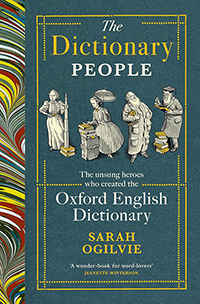Q: You have had a very prominent publication recently. Can you tell us more about it?
 It’s a book called The Dictionary People: The Unsung Heroes of the Oxford English Dictionary and it’s about all the people around the world who helped create the first edition of the OED. At twenty volumes, the OED is the largest English dictionary in the world. It was a large crowd-sourced project, it’s like the Wikipedia of the nineteenth century! But we have never known who all those people were. Nine years ago, I was down in the basement of Oxford University Press where the dictionary archive is stored, and I took the lid off a dusty box. Inside it was a little black book tied with cream ribbon. When I undid the ribbon and opened it, I recognised the immaculate handwriting of James Murray, the longest-serving editor of the dictionary, and I realised that this was his address book that told us who all those people were. It gave us their names and their addresses, each book that they read, the number of slips (a four by six-inch piece of paper bearing quotations illustrating the use of words to be defined in the dictionary) they submitted per book, and the date that he received the slips.
It’s a book called The Dictionary People: The Unsung Heroes of the Oxford English Dictionary and it’s about all the people around the world who helped create the first edition of the OED. At twenty volumes, the OED is the largest English dictionary in the world. It was a large crowd-sourced project, it’s like the Wikipedia of the nineteenth century! But we have never known who all those people were. Nine years ago, I was down in the basement of Oxford University Press where the dictionary archive is stored, and I took the lid off a dusty box. Inside it was a little black book tied with cream ribbon. When I undid the ribbon and opened it, I recognised the immaculate handwriting of James Murray, the longest-serving editor of the dictionary, and I realised that this was his address book that told us who all those people were. It gave us their names and their addresses, each book that they read, the number of slips (a four by six-inch piece of paper bearing quotations illustrating the use of words to be defined in the dictionary) they submitted per book, and the date that he received the slips.
Q: The structure of the book is particularly interesting. How did it come about?
It’s a simple structure, A-Z, but it was difficult to crack. After I had been doing all this research for many years, I was still trying all sorts of different structures and they weren’t working because there are 3000 people and I wanted to ensure I was telling the general story of the creation of the dictionary while also featuring the most captivating and interesting people. Then during the night, it came to me that I could use an alphabetic structure. I had created two large databases during my research: one for all the people, and one for all the books that they read and the words they sent in. I went through the people database and for each person I came up with a classification or a theme. I then grouped the people according to their themes and classifications, and made chapters out of them - A for Archaeologist, B for Best Contributor, C for Cannibal, M for Murderers, Q for Queers, V for Vicars and Vegetarians - that kind of thing. It just worked! It was meant to be, and I feel satisfied that I managed to include almost everything that I wanted.
Q: Over 3000 people contributed to the OED! It must have been an incredibly hard process to track them down and work out who they are.
Yes, it was a laborious process that took 8 years. Some people were more difficult to research than others, especially the top contributor, someone called Thomas Austin, a volunteer who sent in 165,000 slips. He was the hardest to track down. At one stage, I thought he was a porter at Exeter College, or a porter at the Bodleian Library, but that ended up being wrong, and I eventually found out who he really was. Most of the contributors were unknowns but I did manage to track most of them down, and in the process I unravelled some fascinating and unexpected stories - dramatic and quotidien. For some of them, it was almost like they were crying out to be noticed after all of these years, so there was, for me personally, a social justice aspect to it all, where I realised how devoted these people were to helping the dictionary, and yet how little recognition they had received. This book was a chance to shine a light on them finally, and to give them credit because, without them, the dictionary could never have been written.